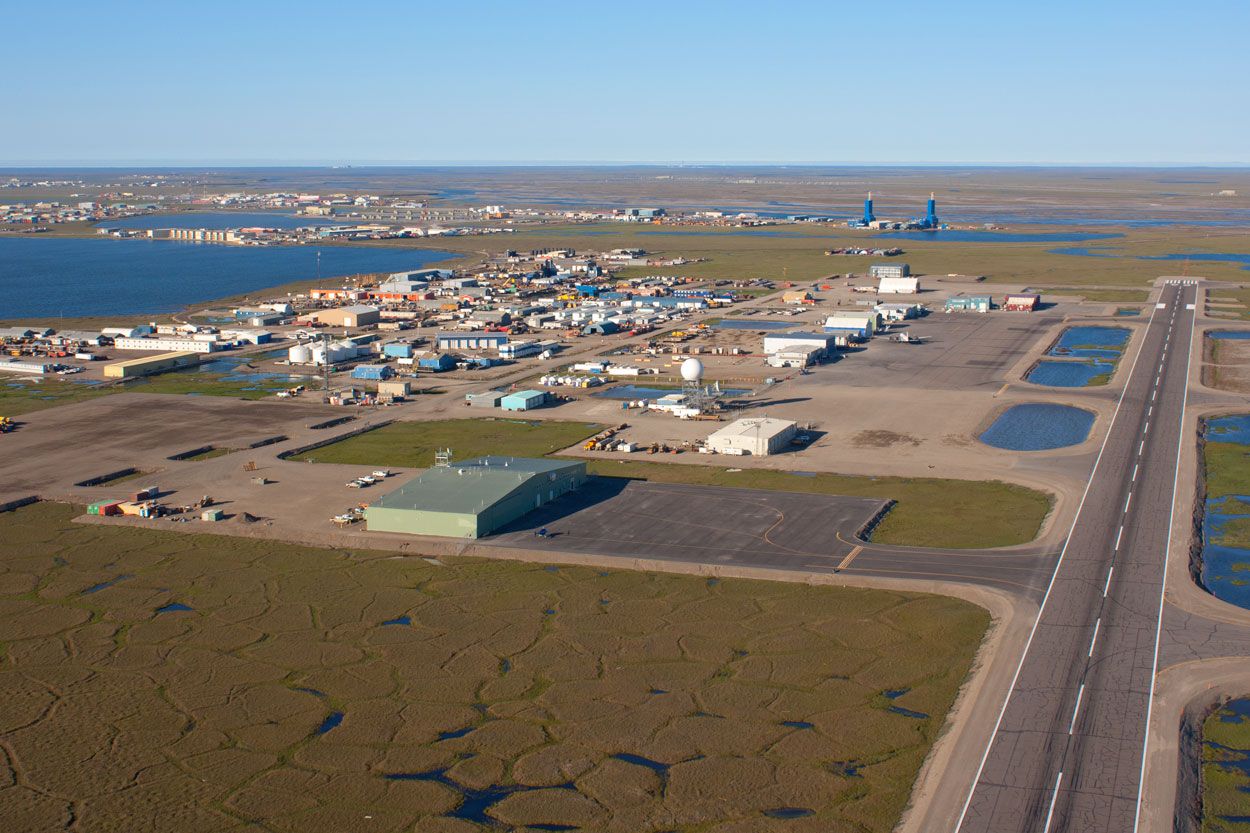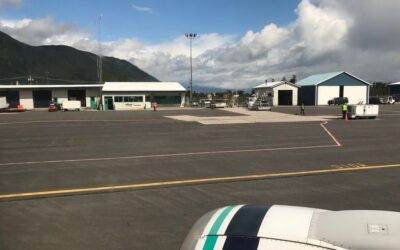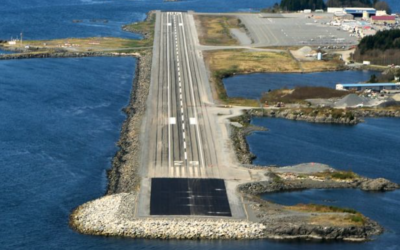Deadhorse Airport (IATA: SCC, ICAO: PASC, FAA LID: SCC), also known as Prudhoe Bay Airport, is located just 5 miles from the Arctic Ocean coast in Alaska’s remote North Slope region. As the northernmost airport in the United States, Deadhorse provides essential aviation access and cargo transport to support Prudhoe Bay’s extensive oil industry operations.
In this comprehensive guide, we’ll explore Deadhorse Airport’s facilities, operations, airlines and role as Alaska’s vital supply line to Arctic oil infrastructure housing over 10,000 oilfield personnel.
Remote Location Among Arctic Oil Infrastructure
Deadhorse Airport lies just 10 feet above sea level on the gravelly Alaskan tundra plains, surrounded by oil wells, processing plants and drilling facilities. Winters are long and frigid while summers still only average a mild 40°F. This lonely outpost 260 miles north of the Arctic Circle is literally aviation’s last frontier.
Inside two modest terminals, Deadhorse Airport provides year-round operations thanks to its extensive runway system totaling over 7,000 feet combined that allows Boeing 737s and cargo planes to land safely. A fleet of tugs and loaders facilitates freight heading to town or North Slope destinations.
Early Days: Pioneering Aviation for Oil Exploration
Deadhorse Airport’s origins trace back to 1968, a period marked by a surge in oil exploration activities in Alaska. The discovery of oil in Prudhoe Bay necessitated a reliable mode of transportation to support the burgeoning industry in this remote area. The airport was initially established as a simple airstrip, primarily to facilitate the transportation of workers, equipment, and supplies essential for oil exploration.
The first significant milestone in the airport’s history was the landing of the first aircraft, a DC-6 freighter operated by an oil company, in 1969. This event marked the beginning of Deadhorse Airport’s crucial role in supporting the oil industry. It provided a gateway for surveyors, engineers, and equipment essential for the initial exploration and subsequent development of the oil fields.
Growth Alongside the Oil Boom
As the oil industry in Prudhoe Bay expanded, so did Deadhorse Airport. The 1970s saw a significant boost in the airport’s infrastructure and capabilities, coinciding with the construction of the Trans-Alaska Pipeline System. The pipeline’s construction brought an influx of workers and equipment to the North Slope, and Deadhorse Airport became the primary air transportation hub for these operations.
The airport evolved from a basic airstrip into a more sophisticated facility, with improved runways, navigation aids, and terminal buildings. This expansion was not only a response to the growing demand from the oil industry but also a necessity to cope with the harsh Arctic conditions, which presented unique challenges for aviation.
Supporting Decades of Oil Production
Over the decades, Deadhorse Airport has continued to grow and adapt, reflecting the ebb and flow of the oil industry in Alaska. In the 1980s and 1990s, as oil production reached its peak, the airport saw further expansions and technological upgrades to accommodate the increasing air traffic. This period also saw the diversification of services at the airport, including cargo handling, aircraft maintenance, and support for scientific research in the Arctic.
In recent years, despite fluctuations in oil production and global oil prices, Deadhorse Airport has remained a vital cog in the logistics that keep the North Slope oilfields operational. It has become a symbol of the enduring relationship between aviation and the oil industry in Alaska, playing a critical role in both the economic development and the exploration of new frontiers in the Arctic.
Inside Deadhorse Airport Facilities
Given its challenging Arctic location, Deadhorse Airport offers functional yet limited terminal facilities split between two small buildings. The main terminal houses operations, a cafeteria, restrooms and baggage claim while the ground level arrivals terminal features rental car desks and waiting areas.
The airport apron provides cargo loading and aircraft ground support like tugs/loaders, maintenance and refueling for the many daily flights arriving from Anchorage transporting personnel and freight. A tall tower dwarfs the flat landscape, directing flight approaches and taxi operations.
Airfield infrastructure includes a primary 6,500 foot asphalt runway plus four secondary landing strips ranging from 5,200 feet down to 3,000 feet for small planes. Combined, this extensive runway system enables Deadhorse to handle 100 daily plane loads of cargo and passengers bound for Prudhoe Bay.
Deadhorse Airport Airlines and Passenger Service
Deadhorse Airport, while the 6th busiest in Alaska, offers limited passenger services. No TSA screening facilities are present, reflecting the airport’s focus on cargo and authorized personnel. Two airlines, ALCAN Cargo and Northern Air Cargo, operate the majority of flights, primarily using Boeing 737 freighter aircraft. These flights are crucial for transporting equipment, supplies, and personnel to support the North Slope’s oil infrastructure.
Roughly 50 daily flights arrive and depart Deadhorse, almost exclusively on Boeing 737 freighter aircraft loaded with fuel, equipment and supplies supporting North Slope oil infrastructure. The airport serves mainly to transport materials, not the public. Personnel and authorized passengers can book charter and limited scheduled flights from Anchorage and Fairbanks.
Adapting to Environmental Challenges
Deadhorse Airport’s existence in an extreme Arctic environment is not just a testament to human engineering but also to adaptability and resilience. The airport’s design and operations are tailored to withstand sub-zero temperatures, icy conditions, and limited daylight hours during the winter months. The infrastructure is built to cope with permafrost, a challenge unique to polar regions. This involves specialized construction techniques and materials that ensure stability and durability in the face of freezing and thawing cycles. The airport’s maintenance teams are skilled in managing ice and snow on runways and in ensuring that navigation and communication systems remain functional in extreme weather conditions.
While primarily serving the oil industry, Deadhorse Airport also impacts the small local community and the broader Alaskan North Slope region. It serves as a crucial link for the few residents and workers in this remote area, providing essential access to medical services, supplies, and connections to the outside world. The airport’s role extends to emergency response, acting as a staging area for search and rescue operations in the vast Arctic wilderness.
The environmental impact of operating an airport in such a sensitive ecosystem is a subject of ongoing consideration. Measures are taken to minimize the ecological footprint, including careful management of fuel and waste, monitoring of wildlife activity around the airport, and adherence to strict environmental regulations. These efforts are crucial in preserving the unique Arctic environment while maintaining essential services.
Economic Role and Future Outlook
As the primary logistics hub sustaining Alaska’s oil industry epicenter at Prudhoe Bay, Deadhorse Airport fills an indispensable niche. By weight, the airport handles over 170 million pounds of cargo yearly, consisting principally of oil infrastructure construction supplies, drilling equipment, machinery and pipeline parts plus everyday goods that make remote living possible.
Technological advancements have played a significant role in Deadhorse Airport’s evolution. From state-of-the-art navigation systems to advanced communication technologies, these innovations ensure safe and efficient operations in the challenging Arctic conditions. The airport has embraced technology not only in air traffic management but also in environmental monitoring, with sensors and systems in place to track weather patterns, wildlife movements, and ecological changes. These technologies are vital for making real-time decisions that affect both flight safety and environmental conservation.
Deadhorse Airport’s continued importance of keeping North Slope oil operations provisioned guarantees its strategic role into the future. Even as Alaska’s oil production declines, ongoing infrastructure maintenance and drilling in extreme Arctic conditions relies on Deadhorse facilitating cargo and passenger movement. No other transport options exist out on the frozen tundra just miles south of the Arctic Ocean.
Despite its remote location and harsh climate, Deadhorse Airport is a hub of activity throughout the year. Its unique position, mere miles south of the Arctic Ocean, on the frozen tundra, makes it an indispensable part of Alaska’s oil industry infrastructure. The airport’s existence and operations not only underline the importance of logistics in remote oil exploration but also highlight the human ability to adapt and thrive in extreme conditions.







0 Comments